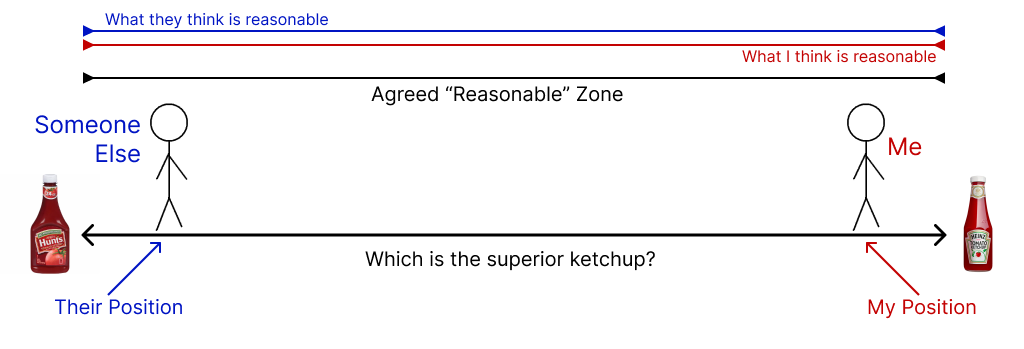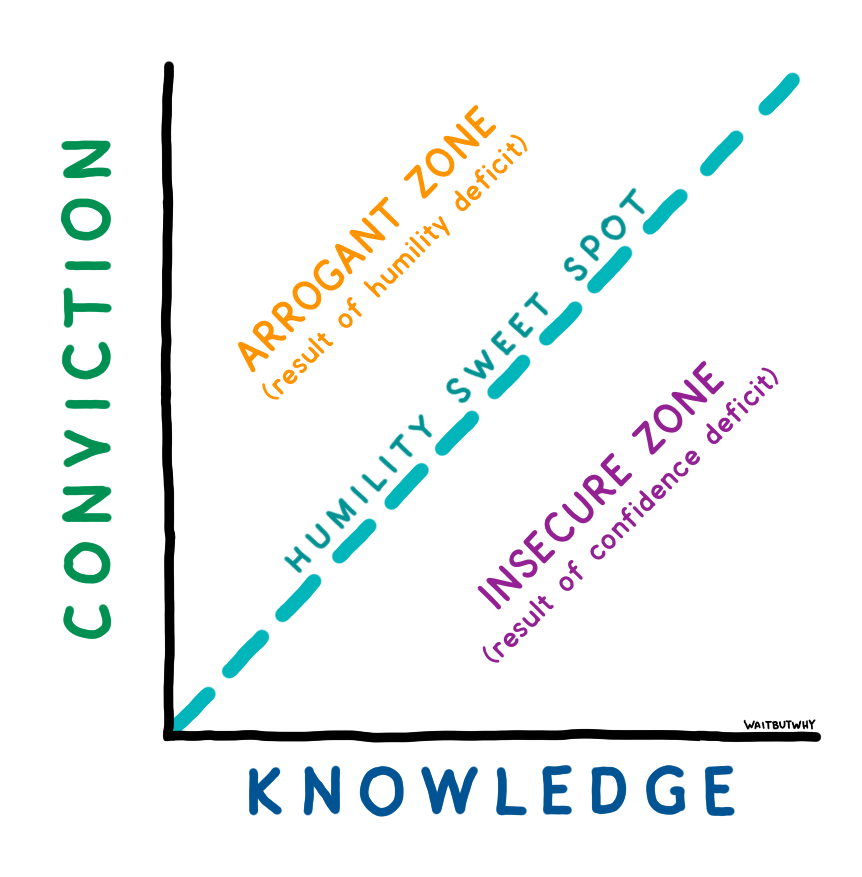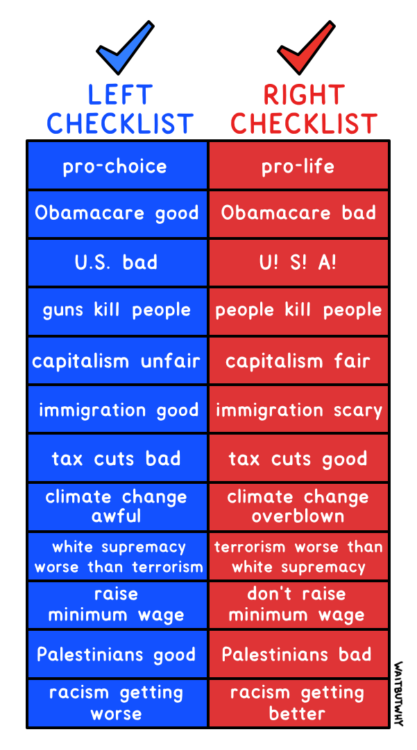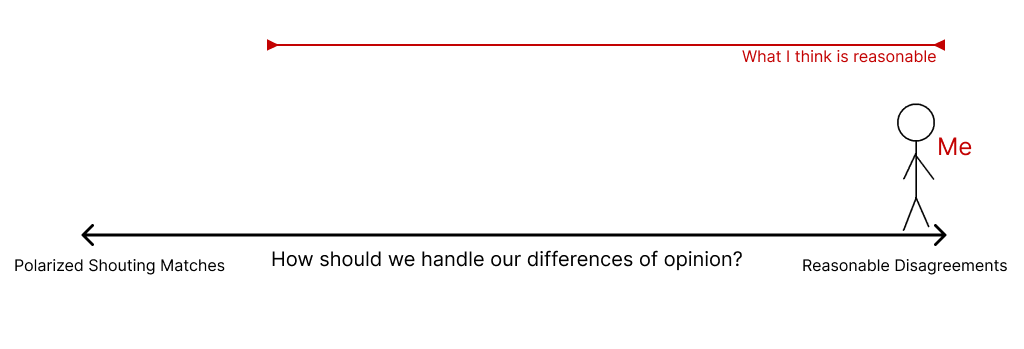
What most Internet debates look like on both sides. Source: xkcd.
We’ve all learned to avoid some topics with certain people in our lives.
You don’t talk politics with your Trump-loving uncle, you don’t bring up God around your atheist neice,
and you certainly do not talk about Ukraine with your Russian hairdresser.
We learn to steer clear of these conversations because they always go poorly.
The best case scenario is one person tuning out and disengaging. If the conversation goes on too long, things can get heated, emotional, and ugly.
Those other people are just so… unreasonable.
At the core of the problem is disagreement—but it’s not just disagreement that’s the problem.
We can disagree about the best athlete of all time, but debate it for hours, loving every minute.
The problem is when disagreement becomes intractable—when there’s no common ground at all.
Online these disagreements are even worse. Not only can we not find common ground—we often don’t even look for it.
Rather than try to understand a different perspective, we speak directly to the people on our side, tallying points in the form of likes,
and feel vindicated in our correctness when we get support.
You might not think much about this problem—you may not even think it is a problem—until
you find yourself holding a different position from those around you.
Then, suddenly, you’re the crazy uncle no one wants to talk to!
I recently had one of these conversations with a friend. One where I was the crazy uncle and I was certain the conversation would go poorly.
Only it…didn’t.
Somehow this conversation was different.
Somehow, by the end—despite coming from pretty different perspectives—we agreed on far more than we disagreed on, we understood each other better, and—most shocking of all—we actually changed each other’s minds a bit.
Afterwards, all I could think was, “How can I have more conversations that go like that?”
Here, I’ll talk about one lesson from that conversation: a small, easy-to-apply tactic that can lead to better disagreements.
It can help us understand each other better, and may even turn disagreement into agreement!
I’ll call it the reasonable frame.
The reasonable frame
This magic, debate-saving tactic is deceptively simple.
When faced with a statement, instead of asking “do I agree with that?” you ask “do I think it is reasonable for someone to believe that?”
That’s it. Oddly, this tiny shift opens up a huge space of potential agreement that is otherwise invisible.
Let’s take a silly example. I love ketchup. I love it. Have you ever had ketchup on pizza? It’s amazing.
Growing up I was a complete ketchup snob. It was Heinz or bust. Anyone who bought Hunt’s—or god forbid, some generic brand—immediately lost my respect.
Heinz was the best ketchup and there wasn’t any room for debate.

Believe it or not, this essay was not sponsored by Heinz. I just like their ketchup.
I still believe that Heinz is a superior ketchup.
If you asked me to defend that position, I might say that other ketchups are too sweet, or don’t have the right flavor balance.
If you tried to convince me that Hunt’s is better than Heinz, you would fail. It is basically impossible to do so.
Our conversation might look something like the below, with a huge, unresolvable disagreement gap in the middle:

But—what if we apply the reasonable frame?
Is Hunt’s better than Heinz? Certainly not. I can fight that to the death.
But—would it be reasonable for someone else to feel that Hunt’s is better?
With that lens, I have to begrudgingly concede that yes, holding that position is, in fact, perfectly reasonable.
That is, while I disagree with you, I can’t say that you are an unreasonable person for feeling differently.
I guess you have a weird mouth or something.
Now our conversation looks more like this:

With the reasonable frame I have to now concede that your position on ketchup is reasonable,
and we’ve immediately gone from having an impossible-to-resolve ketchup war to accepting that
we just have different takes on a spectrum of acceptable beliefs. Conflict resolved!
Ketchup brand preference is a silly example because most people would agree that any preference is reasonable even if they feel differently.
Where the reasonable frame really shines is when the topic is more nuanced.
When the answer isn’t necessarily binary, but includes a broad range of potential opinions.
A question like “how good a president is Joe Biden?” or “what does an effective pandemic policy look like?”
For nuanced topics, reasonable people who disagree will tend to be closer to the center.
And often the conversation they could be having will go from something like this:

To something like this:

When people adopt the reasonable frame, they can often immediately agree that everyone holds a reasonable position.
And once you’ve accepted each other’s position as reasonable, everything else is easier.
The boxing gloves come off, you stop attempting to prove each other wrong,
and you can focus on the ideas and information supporting each other’s views.
In other words, you can have a reasonable disagreement.
The reasonable frame in action
Part 1: Elon and Twitter
Everyone’s talking about Elon Musk’s recent purchase of Twitter for $44 billion.
How you feel about Elon’s purchase largely depends on where you fall on the political spectrum.
Those on the political right have celebrated the acquisition, hopeful it will lead to more free speech and, in turn,
a higher-functioning democracy. Meanwhile, the left is worried about such a large platform in the hands of a single billionaire,
and fear that more free speech might lead to increased hate speech, harassment, and misinformation.

Elon Musk: technologist, entrepreneur, polarizer.
So who’s right? Is Elon buying Twitter a “Berlin Wall” moment for democracy or is it
making the world a scarier place?
Well—regardless of how you feel—instead of asking “do I agree with the other side?” (which you won’t), try asking,
“do I think it is reasonable for someone to feel that way?”
If you’re like me—even if you feel strongly about Elon—you can acknowledge that the opposite position is reasonable.
Part 2: Lia Thomas
Another charged topic in sports and politics is the emergence of Lia Thomas as a dominant college women’s swimmer.
Lia is a transgender woman who transitioned from a man to a woman after her second year of college and is now breaking
records competing on the women’s team.
She hopes to compete in the next Olympics, where she would have a good shot at winning a gold medal.

Transgender swimmer Lia Thomas receiving her NCAA championship in March, 2022.
Supporters of Thomas say that she has a right to compete as the gender she identifies with,
and that to deny her that opportunity would be discrimination.
Opponents of Thomas say that having gone through puberty as a male gives her a unique biological advantage which makes
it unfair for the biological females she is competing against.
There is lots of posturing and name-calling on both sides of this issue, and most people act like their view is the only acceptable view.
But what if you apply the reasonable frame to the debate?
That is, instead of asking “should Lia Thomas be competing in women’s sports?” you ask “is it reasonable to believe Lia Thomas should compete in women’s sports?”
Or—on the other side—“is it reasonable to believe Lia Thomas should not compete in women’s sports?”
For me the answer to both questions is “yes”.
E.g. if you support Lia swimming, hopefully you can have some sympathy for why some people think it’s unfair
to some of the other women she’s competing against.
And if you oppose her swimming, hopefully you can understand why some people feel that it’s important that she and other trans athletes
can participate in safe and welcoming athletic environments.
Even though I have an opinion, I can acknowledge that both sides hold reasonable views,
and it’s a muddy situation where someone is going to not get exactly what they want.
I’m glad no one is asking me to make any decisions about it!
The reasonable zone
Some of you may have read one of the above examples and thought, “wait that doesn’t work at all.”
For some people, the answer to “what do I think about Lia Thomas?” and “what do I think is reasonable to think about Lia Thomas?” are basically the same.
On this topic, they might believe there are a small window of reasonable opinions that closely match their own:

An example of a person with a small “reasonable zone” on a topic. What they think is reasonable very closely matches their own position.
This introduces another layer to the discussion: the reasonable zone.
With the reasonable frame you can see that on any given subject, a person’s opinion is not actually sufficient to represent how they feel. Everyone actually has two traits:
- Their own opinion.
- The space of opinions they believe are “reasonable”. A.k.a their reasonable zone.
Now we can see that two people might have the exact same position on a topic but wildly different reasonable zones.
I love Heinz ketchup, but believe it’s reasonable to prefer Hunt’s.
Someone else might equally love Heinz and think that anyone who supports Hunt’s is mentally deranged.

People with similar views, but very different reasonable zones. In this case “A” can’t have reasonable disagreements, while B can.
Conversations with people with differently-sized reasonable zones will go very differently—even if they have the same position!
What impacts the size of someone’s reasonable zone?
In the picture above, A and B agree on a topic but actually feel very differently about it. A thinks anyone who disagrees with him is unreasonable,
while B thinks it is reasonable to have a broad range of opinions. Why might this be the case?
The size of someone’s reasonable zone is likely a good proxy for their conviction.
The more convinced you are that you’re right, the less you will find any alternative viewpoints to be reasonable,
and the smaller your reasonable zone will be.
So where does our conviction come from?
The first—and best—answer, is evidence. As an example, most people probably do not believe it is reasonable to believe the earth is flat, largely because of the overwhelming amount of evidence that the earth is, in fact, round. So most of us look like this:

I may have lost 1% of readers with this diagram. Oh well.
Unfortunately, most topics don’t have such a clear-cut, evidence-based answer.
Some topics—like Lia Thomas competing—may not be predominantly based on evidence,
but more complex and squishy things like morality, inclusiveness, and fairness.
What do you do then?
Setting that aside—even when we have evidence, it can be difficult to make sense of.
Let’s pretend we’re debating mask mandates.
The first thing we’d probably want to know is how effective masks are at preventing Covid transmission.
You might find an article titled “Do face masks work? Here are 49 scientific studies that explain why they do”
and conclude that masks are great.
Someone else might find an article—published five days later—titled “Do masks actually work? The best studies suggest they don’t,”
and conclude that masks are useless.
Well, shit! Now what?!

Two articles, published five days apart, that claim completely contradictory conclusions about mask effectiveness.
In these cases, conviction would ideally reflect the depth of one’s assessment of the topic.
If you just read one of those headlines your conviction should be basically zero.
If you read both articles it might be a bit higher.
If you read (and understood) the 49 studies supporting masks and the 14 studies saying they do nothing,
then you’d have reason to be pretty confident in your opinion!
Ideally, our conviction on any given topic would look like the “humility sweet spot” line on this chart.
The more we know, the more strongly we hold our belief.

The knowledge/conviction graph, from Wait But Why’s The Thinking Ladder.
Ideally if you knew very little about something, your conviction would be low, and your “reasonable zone” would be big.
This is where things fall apart.
The world is just too big and complicated to have deep, firsthand knowledge on more than a handful of things.
Are you willing to read 63 studies on mask effectiveness to form your opinion? I know I’m not.
Instead we take shortcuts.
We outsource the process of evaluating the knowledge to someone else—perhaps our go-to news site,
our favorite Youtuber, or our friends.
And, if everyone we’ve decided to trust seems to be saying the same thing, our conviction might be high.
But is that right?
How do we know our sources are right? Or—even harder—complete?
The mask articles each painted conflicting, one-sided pictures of an obviously-more-complicated situation.
How often does that happen?
How often are we inhabiting the arrogant zone?
Our collective shrinking reasonableness
It’s no secret that we’ve gotten more polarized in recent years.
Social media apps that optimize for attention have amplified sensationalism and made us angrier.
The business model of news sites has incentivized content that speaks to like-minded ideological bases
and pushed us into warring tribes.
Our discourse has moved online, and long, complex debates have been reduced to a bulleted list of talking-points.

What happens when you push a complex debate into a tribal checklist. Source: Wait But Why
With increased polarization comes smaller reasonable zones.
The more we are surrounded by opinions we agree with, the more we come to believe that those opinions are the only reasonable ones.
And once everyone has a small reasonable zone it becomes impossible to find common ground with people who see the world differently.
We lose our capacity to have reasonable disagreements.

When opposing views are combined with small reasonable zones, we lose the ability to have reasonable disagreements.
Rescuing the Art of Disagreement
So it’s gotten harder and harder to find common ground on anything.
How do we fix that? How do we bring back reasonable disagreements?
First, it’s hard. It’s hard at the individual level, and it’s even harder at the societal level.
That said, here are some things I hope can help:
- Try using the reasonable frame.
Remember—the reasonable frame means replacing “are they right?” with “do I think it’s reasonable to believe that?”
In good-faith conversations, this little trick is often enough to immediately find common ground and turn a bad conversation around.
- Interrogate the size of your reasonable zone.
Your reasonable zone is the space of opinions you consider to be reasonable.
If it’s small, try to figure out why.
Do you know enough about the topic to warrant having such a narrow perspective on acceptable positions?
- Try to expand your worldview.
Ideological echo chambers are a common source of small reasonable zones.
Few people would admit to being in echo-chambers, but if we’re not careful, our media will push us into them.
Instead, try to seek out opinions you disagree with.
For bonus points, try and see if you can adopt—or “steel man”—an opposing viewpoint,
even if you disagree with it.
- Go offline.
Difficult conversations go a lot better when there is room for nuance, body language, and a human being on the opposite side.
Try bringing your disagreements offline, and you’ll be surprised how reasonable people become.
- Practice humility.
Often, the easiest—and most logical—thing to do is to be humble.
You can have your opinion, but give other ones the benefit of the doubt.
Stay in the humility sweet spot and keep your reasonable zone wide open.
It’s easy to be pessimistic about society right now—we’re angry and polarized and things seem to be getting worse every day.
But I think there’s also reason to be optimistic.
People (like myself, and others much better
at this) are realizing how big a problem this is, and trying to figure out how to fight it.
Better disagreement—like many things in life—takes intention and practice, but it’s possible once you try.
So what team do you want to be on?
Team polarized or team reasonable?
I know how I feel.
I even made a diagram for it.

If you liked this, you can help spread the word or
discuss on Hacker News.
I’m spending a lot of energy trying to figure out how we can have more reasonable disagreements and make better decisions together.
If you have any ideas on the topic, please get in touch!
And if you want to follow along, sign up to receive updates below.
Thanks to Rowena Luk, Neal Lesh, and Teddy Kingsbury for helping with drafts of this.
Notes